Tourist Preferences for Revitalizing Wellness Products and Reversing Depopulation in Rural Destinations
Abstract
:1. Introduction
2. Literature Review
3. Methodology
3.1. Study Area
3.2. Data Collection
3.3. Conjoint Analysis (CA)
3.4. Contingent Valuation Method
3.5. Binary Logistic Regression (BLR)
4. Results
4.1. Sociodemographic Characteristics
4.2. Results of Conjoint Analysis
4.3. Results of the Contingent Valuation Method
5. Discussion
6. Conclusions
7. Limitations
Author Contributions
Funding
Data Availability Statement
Conflicts of Interest
Appendix A
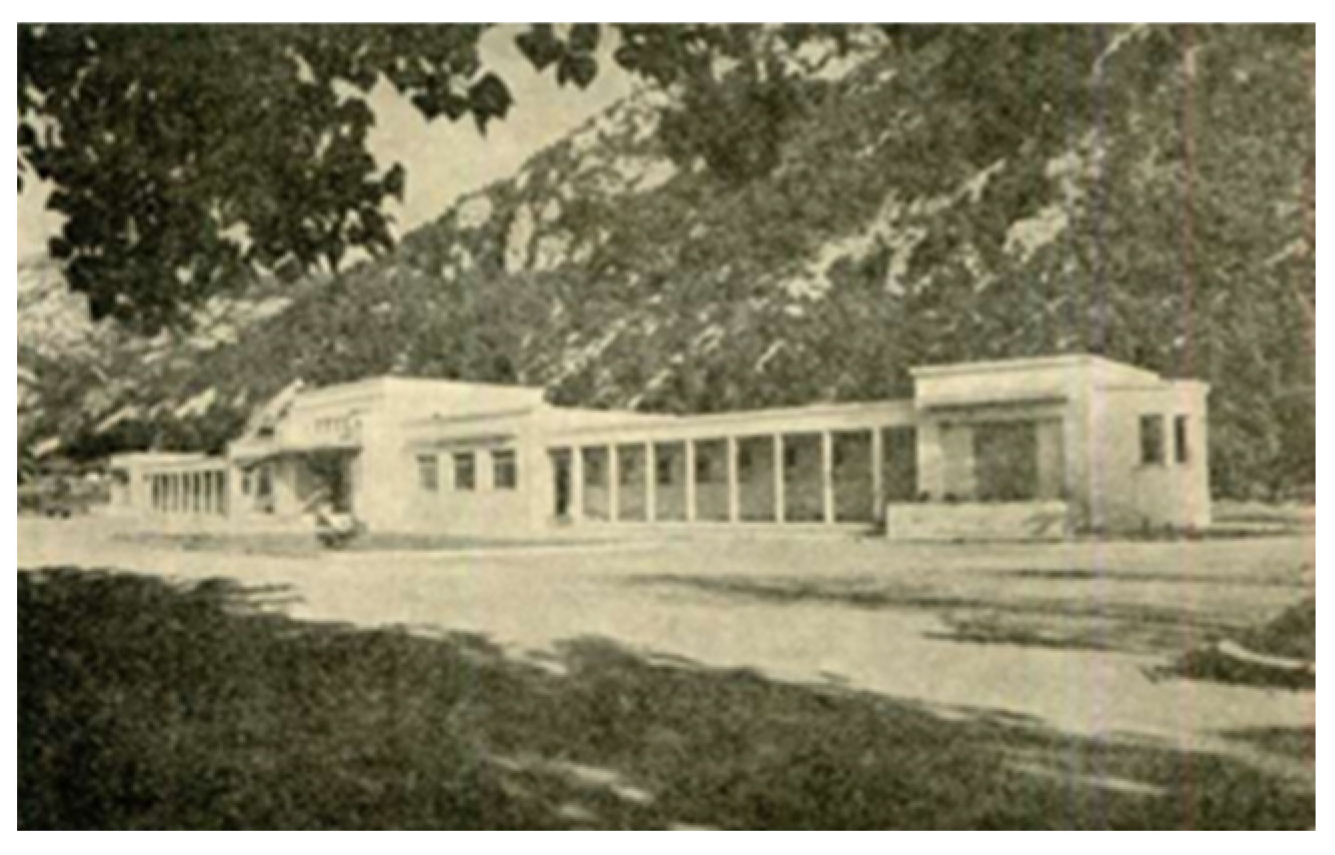
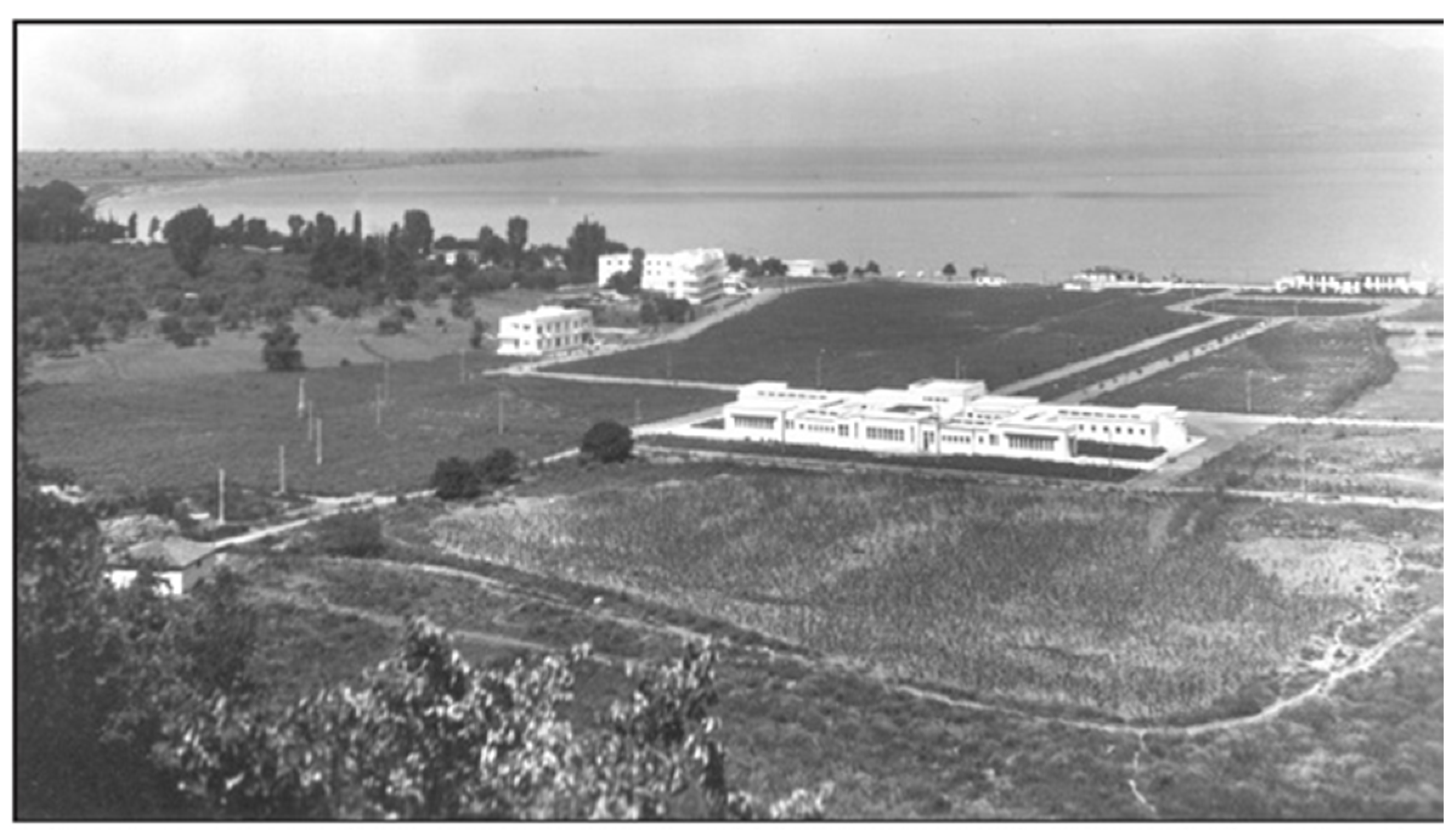


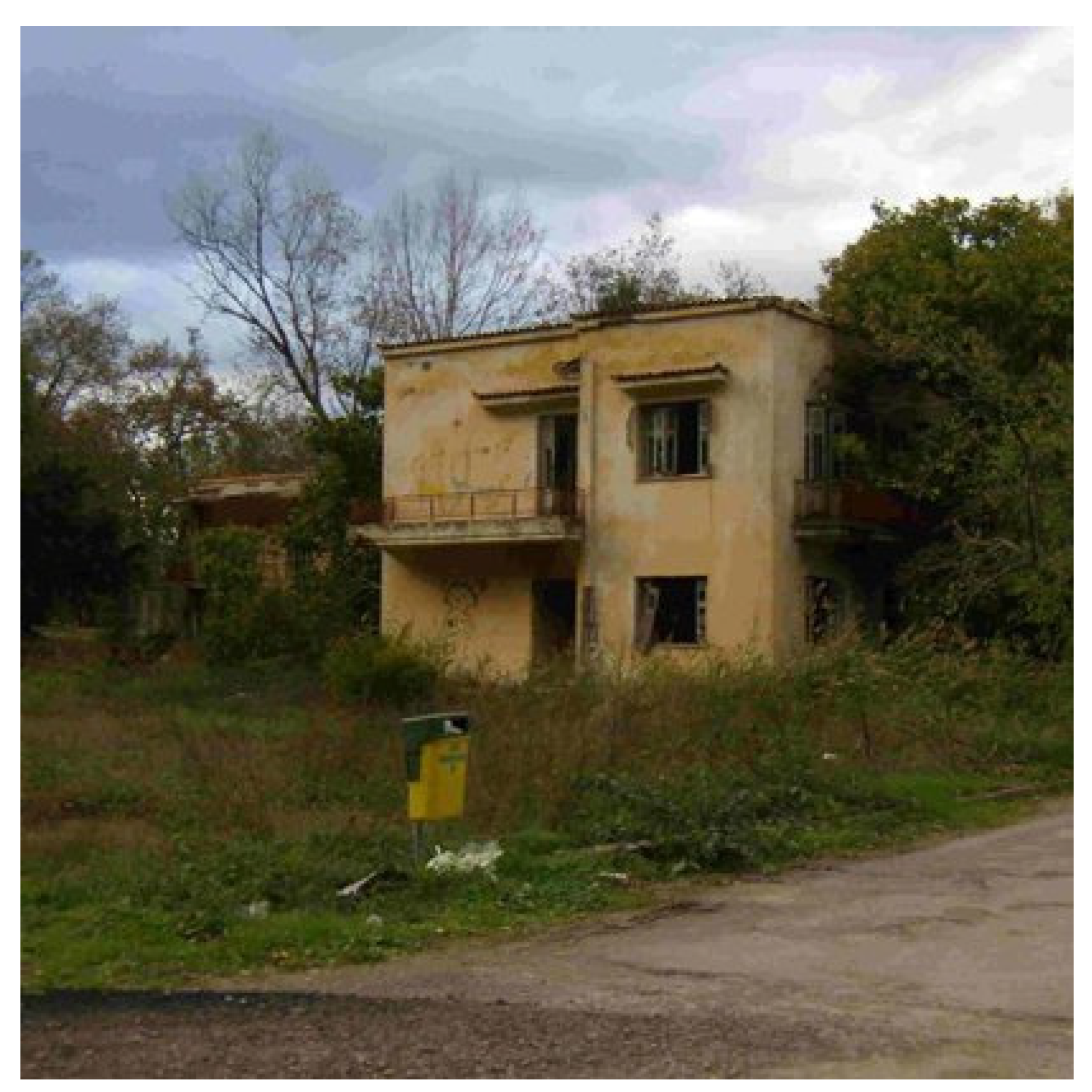
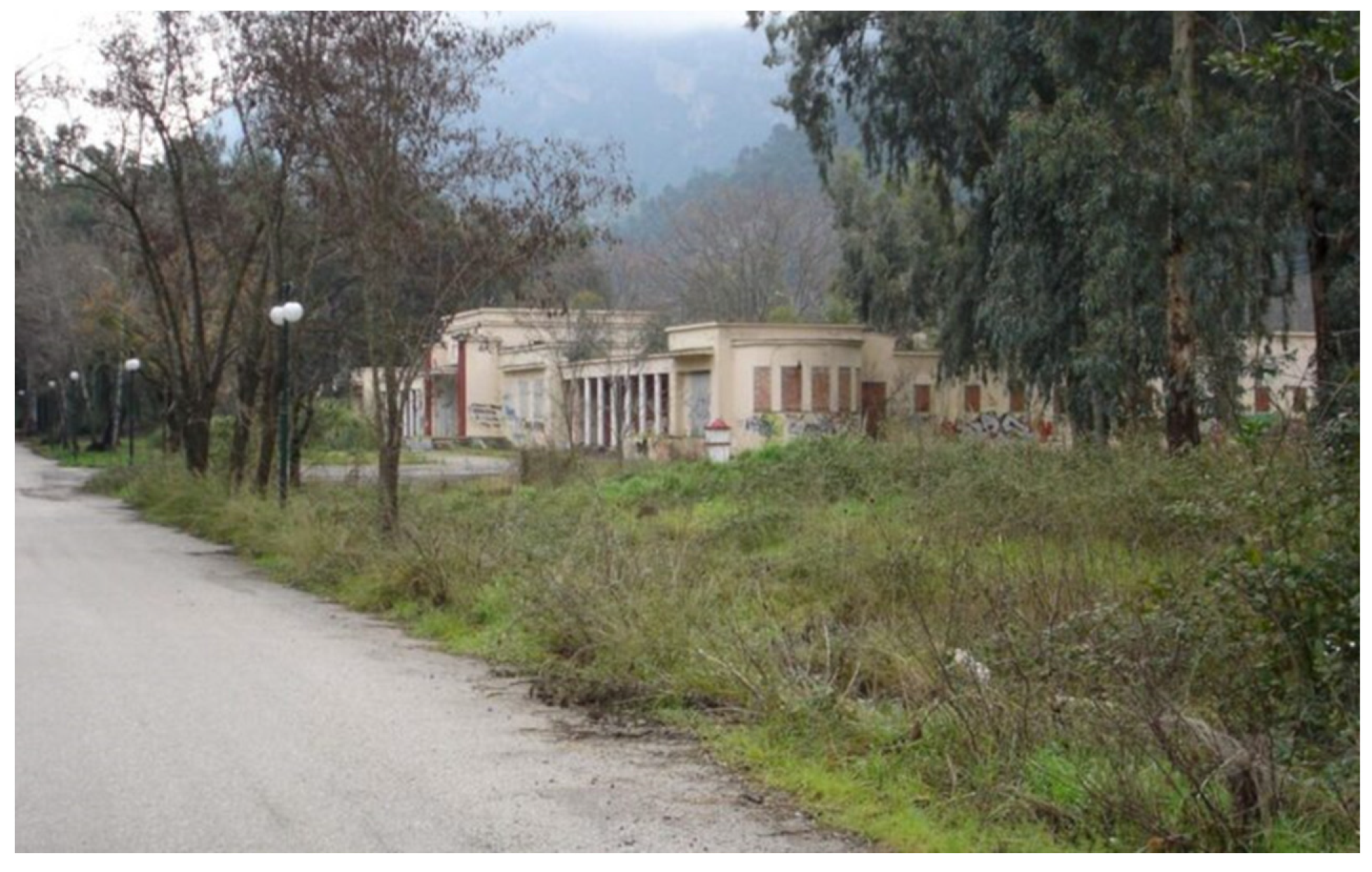
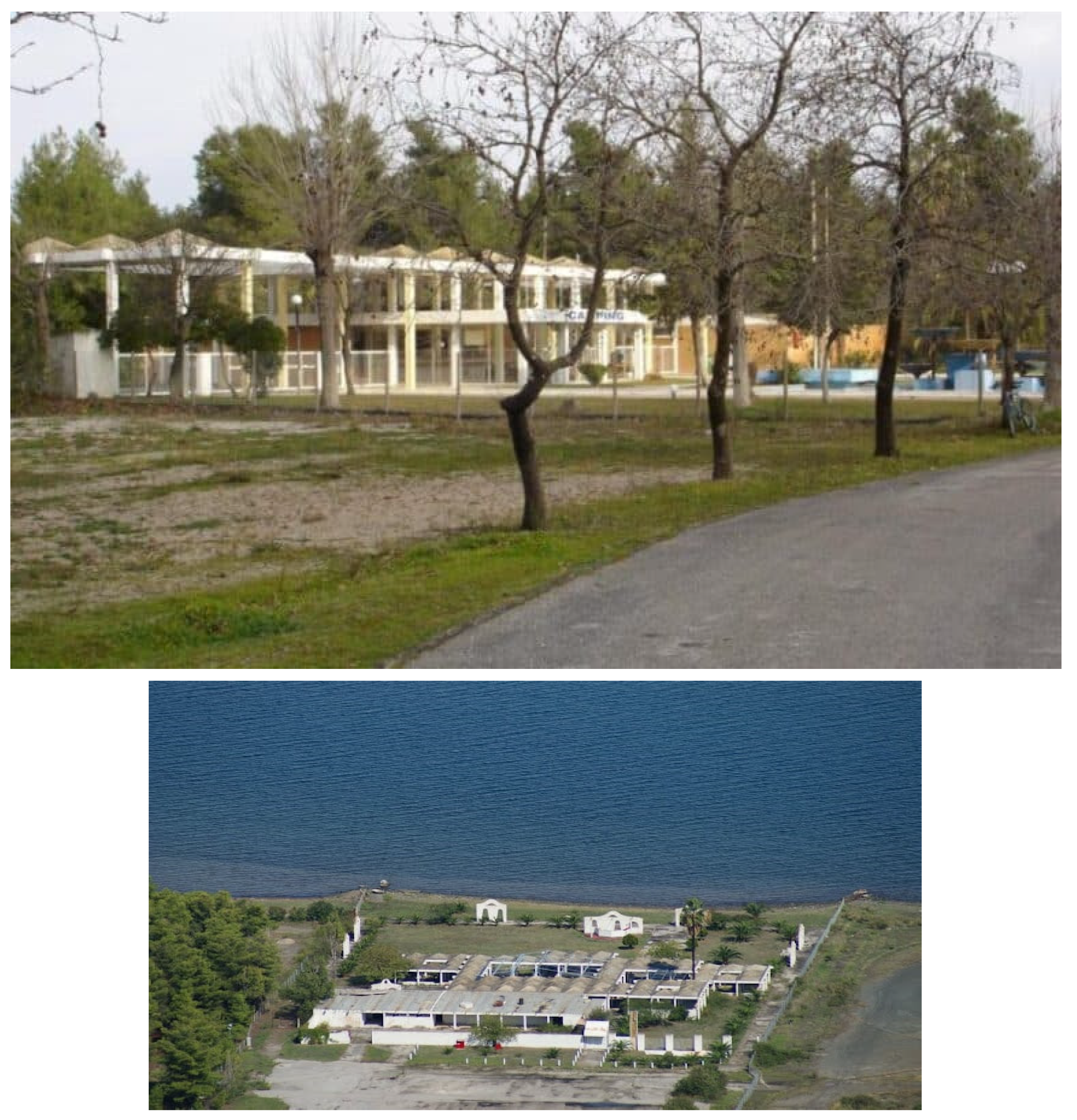
Appendix B
| ID | Time of Visit | Duration of Visit (Days) | Purpose of Visit | Wellness Tourism Services |
|---|---|---|---|---|
| 1 | July–August | 8–14 | Wellness tourism is the main purpose of visit | Physical activities and training |
| 2 | November–March | 8–14 | Wellness tourism is not the main purpose of tourism (Wellness tourism is secondary for my visit) | Physical activities and training and spiritual/emotional enhancement |
| 3 | September–October | 8–14 | Wellness tourism is not the main purpose of tourism (Wellness tourism is secondary for my visit) | Physical activities and training |
| 4 | April–June | 1–7 | Wellness tourism is not the main purpose of tourism (Wellness tourism is secondary for my visit) | Physical activities and training and spiritual/emotional enhancement |
| 5 | July–August | 1–7 | Wellness tourism is not the main purpose of tourism (Wellness tourism is secondary for my visit) | Physical activities and training |
| 6 | April–June | 8–14 | Wellness tourism is the main purpose of visit | Physical activities and training and spiritual/emotional enhancement |
| 7 | November–March | 15+ | Wellness tourism is not the main purpose of tourism (Wellness tourism is secondary for my visit) | Physical activities and training |
| 8 | November–March | 1–7 | Wellness tourism is the main purpose | Physical activities and training |
| 9 | April–June | 15+ | Wellness tourism is the main purpose of visit | Physical activities and training |
| 10 | April–June | 1–7 | Wellness tourism is not the main purpose of tourism (Wellness tourism is secondary for my visit) | Physical activities and training |
| 11 | September–October | 15+ | Wellness tourism is not the main purpose of tourism (Wellness tourism is secondary for my visit) | Physical activities and training and spiritual/emotional enhancement |
| 12 | July–August | 15+ | Wellness tourism is the main purpose of visit | Physical activities and training and spiritual/emotional enhancement |
| 13 | July–August | 1–7 | Wellness tourism is not the main purpose of tourism (Wellness tourism is secondary for my visit) | Spiritual/emotional enhancement—stress relief |
| 14 | September–October | 1–7 | Wellness tourism is the main purpose of visit | Physical activities and training |
| 15 | November–March | 1–7 | Wellness tourism is the main purpose of visit | Spiritual/emotional enhancement—stress relief |
| 16 | September–October | 1–7 | Wellness tourism is the main purpose of visit | Physical activities and training and spiritual/emotional enhancement |
References
- Hospers, G.-J.; Reverda, N. Managing Population Decline in Europe’s Urban and Rural Areas; Springer: Berlin/Heidelberg, Germany, 2015. [Google Scholar]
- Johnson, K.M.; Lichter, D.T. Rural Depopulation: Growth and Decline Processes over the Past Century. Rural Sociol. 2019, 84, 3–27. [Google Scholar] [CrossRef]
- Martinez-Fernandez, C.; Kubo, N.; Noya, A.; Weyman, T. (Eds.) Demographic Change and Local Development: Shrinkage, Regeneration and Social Dynamics; OECD/LEED: Paris, France, 2012. [Google Scholar]
- Rink, D. Shrink Smart: The Governance of Shrinkage within a European Context; Helmholtz Centre for Environmental Research: Leipzig, Germany, 2009. [Google Scholar]
- Coleman, D.; Rowthorn, R. Who’s afraid of population decline? A critical examination of its consequences. Popul. Dev. Rev. 2011, 37, 217–248. [Google Scholar] [CrossRef]
- Paniagua, A. The environmental dimension in the constitution of new social groups in an extremely depopulated rural area of Spain. Land Use Policy 2008, 25, 17–29. [Google Scholar] [CrossRef]
- Pezzini, M. Rural policy lessons from OECD countries. Int. Reg. Sci. Rev. 2001, 24, 134–145. [Google Scholar] [CrossRef]
- Merino, F.; Prats, M.A. Why do some areas depopulate? The role of economic factors and local governments. Cities 2020, 97, 102506. [Google Scholar] [CrossRef]
- Makkonen, T.; Inkinen, T. Benchmarking the vitality of shrinking rural regions in Finland. J. Rural Stud. 2023, 97, 334–344. [Google Scholar] [CrossRef]
- Gao, C.; Cheng, L. Tourism-driven rural spatial restructuring in the metropolitan fringe: An empirical observation. Land Use Policy 2020, 95, 104609. [Google Scholar] [CrossRef]
- Dwyer, L. Tourism development and sustainable well-being: A Beyond GDP perspective. J. Sustain. Tour. 2020, 31, 2399–2416. [Google Scholar] [CrossRef]
- Deng, A.; Lu, J.; Zhao, Z. Rural destination revitalization in China: Applying evolutionary economic geography in tourism governance. Asia Pacific J. Tour. Res. 2021, 26, 215–230. [Google Scholar] [CrossRef]
- López-Sanz, J.M.; Penelas-Leguía, A.; Gutiérrez-Rodríguez, P.; Cuesta-Valiño, P. Sustainable Development and Rural Tourism in Depopulated Areas. Land 2021, 10, 985. [Google Scholar] [CrossRef]
- Sharpley, R.; Sharpley, J. Rural Tourism: An Introduction; International Thomson Business Press: London, UK, 1997. [Google Scholar]
- Panagopoulos, T.; Barreira, A.P. Shrinkage perceptions and smart growth strategies for the municipalities of Portugal. Built. Environ. 2012, 38, 276–292. [Google Scholar] [CrossRef]
- Pesonen, J.A.; Komppula, R. Rural Wellbeing Tourism: Motivations and Expectations. J. Hosp. Tour. Manag. 2010, 17, 150–157. [Google Scholar] [CrossRef]
- Vukovic, P.; Cavlin, G.; Cavlin, M. Complementarity in the development of rural tourism with the development of thermal baths, spa and wellness tourism. Econ. Agric. 2015, 1, 259–270. [Google Scholar] [CrossRef]
- Medina-Munoz, D.R.; Medina-Munoz, R.D. Determinants of expenditures on wellness services: The case of Gran Canaria. Reg. Stud. 2010, 46, 309–319. [Google Scholar] [CrossRef]
- Pyke, S.; Hartwell, H.; Blake, A.; Hemingway, A. Exploring well-being as a tourism product resource. Tour. Manag. 2016, 55, 94–105. [Google Scholar] [CrossRef]
- Mueller, H.; Kaufmann, E.L. Wellness tourism: Market analysis of a special health tourism segment and implications for the hotel industry. J. Vacat. Mark. 2001, 7, 5–17. [Google Scholar] [CrossRef]
- Barkley, B.T.; Saylor, J.H. Customer-Driven Project Management: Building Quality into Project Processes; McGraw Hill: New York, NY, USA, 2001. [Google Scholar]
- Smith, M.; Kelly, C. Wellness Tourism. Tour. Recreat. Res. 2006, 31, 1–4. [Google Scholar] [CrossRef]
- Aparicio, A.E. El turismo rural: Una de las alternativas al desarrollo rural en la Serranía de Cuenca. Cuad. Tur. 2004, 13, 73–89. [Google Scholar]
- Loehr, J.; Becken, S.; Nalau, J.; Mackey, B. Exploring the multiple benefits of ecosystem-based adaptation in tourism for climate risks and destination well-being. J. Hosp. Tour. Res. 2020, 46, 518–543. [Google Scholar] [CrossRef]
- Devereux, C.; Carnegie, E. Pilgrimage: Journeying beyond self. Tour. Recreat. Res. 2006, 31, 47–56. [Google Scholar] [CrossRef]
- Jolliffe, L.; Cave, J. Health and wellness tourism. In Tourism: The Key Concepts; Robinson, P., Ed.; Routledge: London, UK, 2012. [Google Scholar]
- Bushell, R.; Sheldon, P.J. Wellness and Tourism: Mind, Body, Spirit, Place; Cognizant Communication: New York, NY, USA, 2009. [Google Scholar]
- Steiner, C.J.; Reisinger, Y. Ringing the fourfold: A philosophical framework for thinking about wellness tourism. Tour. Recreat. Res. 2006, 31, 5–14. [Google Scholar] [CrossRef]
- Global Spa and Wellness Summit; SRI. The Global Wellness Tourism Economy. Travel and Tourism Research Association: Advancing Tourism Research Globally. 15. 2017. Available online: https://scholarworks.umass.edu/ttra/2013marketing/White_Papers/15 (accessed on 20 July 2023).
- Huang, L.; Xu, H. Therapeutic landscapes and longevity: Wellness tourism in Bama. Soc. Sci. Med. 2018, 197, 24–32. [Google Scholar] [CrossRef] [PubMed]
- Voigt, C.; Brown, G.; Howat, G. Wellness tourists: In search of transformation. Tour. Rev. 2011, 66, 16–30. [Google Scholar] [CrossRef]
- Kelly, C. Analysing wellness tourism provision: A retreat operators’ study. J. Hosp. Tour. Manag. 2010, 17, 108–116. [Google Scholar] [CrossRef]
- Rodrigues, A.; Kastenholz, K.; Rodrigues, A. Hiking as a wellness activity—An exploratory study of hiking tourists in Portugal. J. Vacat. Mark. 2010, 16, 331–343. [Google Scholar] [CrossRef]
- Page, S.J.; Hartwell, H.; Johns, N.; Fyall, A.; Ladkin, A.; Hemingway, A. Case study: Wellness, tourism and small business development in a UK coastal resort: Public engagement in practice. Tour. Manag. 2017, 60, 466–477. [Google Scholar] [CrossRef]
- Heung, V.C.; Kucukusta, D. Wellness tourism in China: Resources, development and marketing. Int. J. Tour. Res. 2013, 15, 346–359. [Google Scholar] [CrossRef]
- Huijbens, E.H. Developing wellness in Iceland. Theming wellness destinations the Nordic way. Scand. J. Hosp. Tour. 2011, 11, 20–41. [Google Scholar] [CrossRef]
- Mak, A.H.N.; Wong, K.K.F.; Chang, R.C.Y. Health or self-indulgence? The motivations and characteristics of Spa-goers. Int. J. Tour. Res. 2009, 11, 185–199. [Google Scholar] [CrossRef]
- Voigt, C.; Howat, G.; Brown, G. Hedonic and eudaimonic experiences among wellness tourists: An exploratory enquiry. Ann. Leis. Res. 2010, 13, 541–562. [Google Scholar] [CrossRef]
- Hamed, H.M. Wellness Tourism: An Initiative for Comprising Wellness Tourism Vacations within the Corporate Wellness Strategy. Am. J. Tour. Res. 2015, 4, 52–67. [Google Scholar] [CrossRef]
- Shokri Garjan, H.; Mahdi Paydar, M.; Divsalar, R. A sustainable supply chain for a wellness tourism center considering discount and quality of service. Expert Syst. Appl. 2023, 211, 118682. [Google Scholar] [CrossRef]
- Dillette, A.K.; Douglas, A.C.; Andrzejewski, C. Dimensions of holistic wellness as a result of international wellness tourism experiences. Curr. Issues Tour. 2020, 24, 794–810. [Google Scholar] [CrossRef]
- Global Wellness Institute. 2020 Compendium: Resetting the World with Wellness; GWI: Miami, FL, USA, 2020. [Google Scholar]
- Romao, J.; Machino, K.; Nijkamp, P. Integrative diversification of wellness tourism services in rural areas—An operational framework model applied to east Hokkaido (Japan). Asia Pac. J. Tour. Res. 2018, 23, 734–746. [Google Scholar] [CrossRef]
- Kazakov, S.; Oyner, O. Wellness tourism: A perspective article. Tour. Rev. 2020, 76, 58–63. [Google Scholar] [CrossRef]
- Stara, J.; Peterson, C. Understanding the concept of wellness for the future of the tourism industry: A literature review. J. Tour. Serv. 2017, 8, 18–29. Available online: https://www.vso.cz/pdf/journal-of-tourism_14-2017-final.pdf (accessed on 21 July 2023).
- Wang, K.; Xu, H.; Huang, L. Wellness tourism and spatial stigma: A case study of Bama, China. Tour. Manag. 2020, 78, 104039. [Google Scholar] [CrossRef]
- Goodarzi, M.; Haghtalab, N.; Shamshiry, E. Wellness tourism in Sareyn, Iran: Resources, planning and development. Curr. Issues Tour. 2016, 19, 1071–1076. [Google Scholar] [CrossRef]
- Kucukusta, D.; Heung, V.C. The problems of developing wellness tourism in China: From supply perspective. J. China Tour. Res. 2012, 8, 146–158. [Google Scholar] [CrossRef]
- Lee, C.F.; King, B.E. Using the Delphi method to assess the potential of Taiwan’s hot springs tourism sector. Int. J. Tour. Res. 2008, 10, 341–352. [Google Scholar] [CrossRef]
- Supapol, A.B.; Barrows, D.; Barrows, A. Canadian health and wellness tourism: Obstacles impeding international competitiveness. Innov. J. Public Sect. Innov. J. 2007, 12, 1–18. [Google Scholar]
- Hallab, Z. Catering to the healthy-living vacationer. J. Vacat. Mark. 2006, 12, 71–91. [Google Scholar] [CrossRef]
- Sayadi, S.; Gonzales Roa, C.; Calatrava Requena, J. Ranking versus scale rating in conjoint analysis: Evaluating landscapes in mountainous regions in southeastern Spain. Ecol. Econ. 2005, 55, 539–550. [Google Scholar] [CrossRef]
- Williams, P.W.; Andestad, G.; Pollock, A.; Dossa, K.B. Health spa travel markets: Mexican long-haul pleasure travellers. J. Vacat. Mark. 1996, 3, 10–31. [Google Scholar] [CrossRef]
- Kim, E.; Chiang, L.; Tang, L. Investigating wellness tourists’ motivation, engagement, and loyalty: In search of the missing link. J. Travel Tour. Mark. 2017, 34, 867–879. [Google Scholar] [CrossRef]
- Lim, Y.J.; Kim, H.K.; Lee, T.J. Visitor motivational factors and level of satisfaction in wellness tourism: Comparison between first-time visitors and repeat visitors. Asia Pacific J. Tour. Res. 2016, 21, 137–156. [Google Scholar] [CrossRef]
- Luo, Y.; Lanlung, C.; Kim, E.; Tang, L.R.; Song, S.M. Towards quality of life: The effects of the wellness tourism experience. J. Travel Tour. Mark. 2018, 35, 410–424. [Google Scholar] [CrossRef]
- Thal, K.I.; Hudson, S. A conceptual model of wellness destination characteristics that contribute to psychological well-being. J. Hosp. Tour. Res. 2017, 43, 41–57. [Google Scholar] [CrossRef]
- Hudson, S.; Thal, K.; Cardenas, D.; Meng, F. Wellness tourism: Stress alleviation or indulging healthful habits? Int. J. Cult. Tour. Hosp. Res. 2017, 11, 35–52. [Google Scholar] [CrossRef]
- Lehto, X.Y.; Brown, S.; Chen, Y.; Morrison, A.M. Yoga tourism as a niche within the wellness tourism market. Tour. Recreat. Res. 2006, 31, 25–35. [Google Scholar] [CrossRef]
- Kozak, M.; Buhalis, D. Cross–border tourism destination marketing: Prerequisites and critical success factors. J. Dest. Mark. Manag. 2021, 14, 100392. [Google Scholar] [CrossRef]
- Suh, Y.-K.; Gartner, W.C. Preferences and trip expenditures—A conjoint analysis of visitors to Seoul, Korea. Tour. Manag. 2004, 25, 127–137. [Google Scholar] [CrossRef]
- Tripathi, S.N.; Siddiqui, M.H. An empirical study of tourist preferences using conjoint analysis. Int. J. Bus. Sci. Appl. Manag. 2010, 5, 1–16. [Google Scholar] [CrossRef]
- Oh, H.C.; Uysal, M.; Weaver, P.A. Product Bundles and Market Segments Based on Travel Motivations: A Canonical Correlation Approach. Int. J. Hosp. Manag. 1995, 14, 123–137. [Google Scholar] [CrossRef]
- Chen, J.S.; Prebensen, N.; Huan, T.C. Determining the motivation of wellness travelers. Anatolia 2008, 19, 103–115. [Google Scholar] [CrossRef]
- Hun Kim, B.; Batra, A. Healthy-living behaviour status and motivational characteristics of foreign tourists to visit wellness facilities in Bangkok. In Proceedings of the 2nd Annual PSU Phuket Research Conference, Songkhla, Thailand, 18–20 November 2009; pp. 1–8. [Google Scholar]
- Gabor, M.R.; Oltean, F.D. Babymoon tourism between emotional well-being service for medical tourism and niche tourism. Development and awareness on Romanian educated women. Tour. Manag. 2019, 70, 170–175. [Google Scholar] [CrossRef]
- Laing, J.H.; Voigt, C.; Wray, M.; Brown, G.; Weiler, B.; Howat, G.; Tremath, R. Sand, surf, spa and spirituality? Examination of a scoping study of medical and wellness tourism in Australia. In Proceedings of the Travel and Tourism Research Association European Chapter Conference Proceedings: Health wellness and tourism—Healthy tourists, healthy business? Budapest, Hungary, 1–3 September 2010; pp. 1–14. [Google Scholar]
- Pan, X.; Yang, Z.; Han, F.; Lu, Y.; Liu, Q. Evaluating potential areas for mountain wellness tourism: A case study of Ili, Xinjiang Province. Sustainability 2019, 11, 5668. [Google Scholar] [CrossRef]
- Kreiger, B.; Mostokowitz, H.; Rabino, S. What Customers Want from a Cruise Vacation: Using Internet-Enabled Conjoint Analysis to Understand the Customer’s Mind. J. Hosp. Mark. Manag. 2005, 13, 83–111. [Google Scholar] [CrossRef]
- Won, D.; Hwang, S. Factors Influencing the College Skiers and Snowboarders Choice of a Ski Destination in Korea: A Conjoint Analysis. Manag. Leis. 2009, 14, 17–27. [Google Scholar] [CrossRef]
- Hwang, S.; Won, D. A Conjoint Analysis Regarding Influencing Factors of Golfers’ Preferred Driving Ranges in Korea. J. Travel Tour. Mark. 2010, 1, 227–237. [Google Scholar] [CrossRef]
- Arenoe, B.; van der Res, J.-P.I.; Kattuman, P. Game theoretic pricing models in hotel revenue management: An equilibrium choice-based conjoint analysis approach. Tour. Manag. 2015, 51, 96–102. [Google Scholar] [CrossRef]
- Carmichael, B. Conjoint analysis, tourism. In Encyclopedia of Tourism; Jafari, J., Xiao, H., Eds.; Springer: Berlin/Heidelberg, Germany, 2005. [Google Scholar] [CrossRef]
- Nuraeni, S.; Pradiva Arrub, A.; Novani, S. Understanding Consumer Decision-Making in Tourism Sector: Conjoint Analysis. In Procedia—Social and Behavioral Sciences, Proceedings of the 6th Indonesia International Conference on Innovation, Entrepreneurship and Small Business, Bandung, Indonesia, 12–14 August 2014; Elsevier: Amsterdam, The Netherlands, 2015; Volume 169, pp. 312–317. [Google Scholar]
- Li, J.; Hudson, S. Conjoint Analysis of Consumer Preferences to Destination Brand Attributes. In Travel and Tourism Research Association: Advancing Tourism Research Globally; TTRA: Lapeer, MI, USA, 2015; Volume 22. [Google Scholar]
- Zhang, J.; Wei, X.; Fukuda, H.; Zhang, L.; Ji, X. A Choice-based conjoint analysis of social media picture posting and souvenir purchasing preference: A case study of social analytics on tourism. Inf. Process. Manag. 2021, 58, 102716. [Google Scholar] [CrossRef]
- Huang, J.-C.; Haab, T.C.; Whitehead, J.C. Willingness to Pay for Quality Improvements: Should Revealed and Stated Preference Data Be Combined? J. Environ. Econ. Manag. 1997, 34, 240–255. [Google Scholar] [CrossRef]
- Ekstrand, R.E.; Loomis, J. Incorporating respondent uncertainty when estimating willingness to pay for protecting critical habitat for threatened and endangered fish. Water Resour. Res. 1998, 34, 3149–3155. [Google Scholar] [CrossRef]
- Machado, F.; Mourato, S. Improving the assessment of the water related health impacts: Evidence from coastal waters in Portugal. In Proceedings of the First World Congress on Environmental and Resource Economics, Venice, Italy, 25–27 June 1998. [Google Scholar]
- Blakemore, F.B.; Williams, A.T.; Ozhan, E. Tourist valuation of Olu Deniz beach, Turkey, using contingent valuation and travel cost approaches. J. World Leis. 2000, 4, 48–55. [Google Scholar] [CrossRef]
- Togridou, A.; Hovardas, T.; Pantis, J.D. Determinants of visitors; willingness to pay for the national marine park in Zakynthos. Ecol. Econ. 2006, 60, 308–319. [Google Scholar] [CrossRef]
- Ahmad, S.A. Visitors’ Willingness to Pay for an Entrance Fee: A Case Study of Marine Parks in Malaysia. Ph.D. Dissertation, University of Glasgow, Glasgow, UK, 2009. [Google Scholar]
- Halkos, G.; Matsiori, S. Economic Valuation of Coastal Zone Quality Improvements; MPRA: Fort Leonard Wood, MO, USA, 2011; p. 35395. [Google Scholar]
- Jurado-Rivas, C.; Sánchez-Rivero, M. Willingness to Pay for More Sustainable Tourism Destinations in World Heritage Cities: The Case of Caceres, Spain. Sustainability 2019, 11, 5880. [Google Scholar] [CrossRef]
- Vespestad, M.K.; Gressnes, T. Tourists’ willingness to pay for nature-based tourism experiences. Tour. Anal. 2021, 26, 319–332. [Google Scholar] [CrossRef]
- Duran-Roman, J.L.; Cardenas-García, P.J.; Pulido-Fernandez, J.K.I. Tourists’ willingness to pay to improve sustainability and experience at destination. J. Destin. Mark. Manag. 2021, 19, 100540. [Google Scholar] [CrossRef]
- Xiao, J.; Wang, M.; Xue, G. Valuing tourists’ willingness to pay for conserving the nonuse values of marine tourism resources: A comparison of three archipelagic tourism destinations in China. J. Sustain. Tour. 2021, 29, 678–710. [Google Scholar] [CrossRef]
- Boto-Garcia, D.; Mariel, P.; Pino, J.B.; Alvarez, A. Tourists’ willingness to pay for holiday trip characteristics: A Discrete Choice Experiment. Tour. Econ. 2022, 28, 349–370. [Google Scholar] [CrossRef]
- Anagostou, A.; Ekonomou, G.; Kallioras, D. The Nexus of Tourism Spending with Economic Performance: A Panel Data Analysis for the Eurozone Area. Geogr. Pannonica 2021, 25, 35–44. [Google Scholar] [CrossRef]
- Ritchie, H.; Roser, M. Urbanization. Our World in Data. 2018. Available online: https://ourworldindata.org/urbanization (accessed on 21 July 2023).
- Zvaigzne, A.; Litavniece, L.; Dembovska, I. Tourism seasonality: The causes and effects. Worldw. Hosp. Tour. 2021, 14, 421–430. [Google Scholar] [CrossRef]
- Eurostat Statistics Explained. Seasonality in Tourism Demand: Nearly One in Four Trips of EU Residents made in July or August. 2021. Available online: https://ec.europa.eu/eurostat/statistics-explained/index.php?title=Seasonality_in_tourism_demand#Nearly_one_in_four_trips_of_EU_residents_made_in_July_or_August (accessed on 26 November 2023).
- Martínez, J.M.G.; Martín, J.M.M.; Fernández, J.A.S.; Mogorrón-Guerrero, H. An analysis of the stability of rural tourism as a desired condition for sustainable tourism. J. Bus. Res. 2019, 100, 165–174. [Google Scholar] [CrossRef]
- Butler, R.; Mao, B. Seasonality in tourism: Problems and measurement. In Quality Management in Urban Tourism; Murphy, P., Ed.; Wiley: Chichester, UK, 1997; pp. 9–23. [Google Scholar]
- Global Wellness Institute. Wellness Tourism. Available online: https://globalwellnessinstitute.org/what-is-wellness/what-is-wellness-tourism/ (accessed on 26 November 2023).
- Kozak, M. Repeaters’ behaviour at two distinct destinations. Ann. Tour. Res. 2001, 28, 784–807. [Google Scholar] [CrossRef]
- Frochot, I.; Morrison, A.M. Benefit segmentation: A review of its applications to travel and tourism research. J. Travel Tour. Mark. 2000, 9, 21–45. [Google Scholar] [CrossRef]
- Jurdana, D.S.; Zmijanovic, L. The effect of tourism seasonality on protected areas. In Tourism and Hospitality Industry Section 2–4; University of Rijeka, Faculty of Tourism and Hospitality Management: Rijeka, Croatia, 2014; p. 131. [Google Scholar]
- Butler, R.W. Seasonality in Tourism: Issues and Implication, In Tourism: A State of the Art; Seaton, A.V., Ed.; Wiley: Chichester, UK, 1994; pp. 332–339. [Google Scholar]
- Lohr, S. Sampling: Design and Analysis (Chapman & Hall/CRC Texts in Statistical Science), 2nd ed.; Routledge: London, UK, 2019. [Google Scholar]
- Ahmed, S. Methods in Sample Surveys. Cluster Sampling; John Hopkins Bloomberg School of Public Health: Baltimore, MD, USA, 2009. [Google Scholar]
- Hoshaw-Woodard, S. Description and Comparison of the Methods of Cluster Sampling and Lot Quality Assurance Sampling to Assess Immunization Coverage; Department of Vaccines and Biologicals, World Health Organization: Geneva, Switzerland, 2001. [Google Scholar]
- Zelin, A.; Stubbs, R. Cluster Sampling: A False Economy? Int. J. Mark. Res. 2005, 47, 501–522. [Google Scholar] [CrossRef]
- Vallée, J.; Souris, M.; Fournet, F.; Bochaton, A.; Mobillion, V.; Peyronnie, K.; Salem, G. Sampling in health geography: Reconciling geographical objectives and probabilistic methods. An example of a health survey in Vientiane (Lao PDR). Emerg. Themes Epidemiol. 2007, 4, 6. [Google Scholar] [CrossRef]
- Leo, L. Role of cluster sampling in market research. Int. J. Mark. Res. 2009, 49, 306–321. [Google Scholar]
- Jackson, S.L. Research Methods and Statistics: A Critical Approach, 4th ed.; Cengage Learning: Boston, MA, USA, 2011. [Google Scholar]
- Reutterer, T.; Kotzab, H.W. The use of conjoint-analysis for measuring preferences in Supply chain design. Ind. Mark. Manag. 2000, 29, 27–35. [Google Scholar] [CrossRef]
- Louviere, J.L.; Flynn, T.N.; Carson, R.T. Discrete choice experiments are not conjoint analysis. J. Choice Model. 2010, 3, 57–72. [Google Scholar] [CrossRef]
- Alvarez-Farizo, B.; Hanley, N. Using conjoint analysis to quantify public references over the environmental impacts of wind farms. An example from Spain. Energy Policy 2002, 30, 107–116. [Google Scholar] [CrossRef]
- Danaher, P.J. Using conjoint analysis to determine the relative importance of service attributes measured in customer satisfaction surveys. J. Retail. 1997, 73, 235–260. [Google Scholar] [CrossRef]
- Huber, J. Conjoint analysis: How we got here and where we are (an update). In Sawtooth Software, Research Papers Series; Sawtooth Software, Inc.: Sequim, WA, USA, 2005. [Google Scholar]
- Cheung, H.D.; Chang, T.M. A study on subjective preference to daylit residential indoor environment using conjoint analysis. Build Environ. 2008, 43, 2101–2111. [Google Scholar] [CrossRef]
- Green, P.E.; Krieger, A.M.; Wind, Y. Thirty Years of Conjoint Analysis: Reflections and Prospects; Springer: New York, NY, USA, 2004; pp. 117–139. [Google Scholar]
- Agarwal, M.K.; Green, P.E. Adaptive conjoint analysis versus self-explicated models: Some empirical results. Int. J. Res. Mark. 1991, 8, 141–146. [Google Scholar] [CrossRef]
- Andersen, R.C.; Hansen, E.C. The impact of environmental certification preferences for wood furniture: A conjoint analysis approach. For. Prod. J. 2004, 54, 42–50. [Google Scholar]
- Milon, W.J.; Alvarez, S. The Elusive Quest for Valuation of Coastal and Marine Ecosystem Services. Water 2019, 11, 1518. [Google Scholar] [CrossRef]
- Polyzos, S.; Minetos, D. Valuing environmental resources in the context of flood and coastal defence project appraisal. A case-study of Poole Borough Council seafront in the UK. Manag. Environ. Qual. Int. J. 2007, 18, 694–710. [Google Scholar] [CrossRef]
- Markandya, A.; Ortiz, R.A. Encyclopedia of Environmental Health; Elsevier: Amsterdam, The Netherlands, 2011. [Google Scholar]
- Johnston, R.J.; Boyle, K.J.; Adamowicz, W.; Bennett, J.; Brouwer, R.; Cameron, T.A.; Vossler, C.A. Contemporary guidance for stated preference studies. J. Assoc. Environ. Resour. Econ. 2017, 4, 319–405. [Google Scholar] [CrossRef]
- Arrow, K.; Solow, R.; Portney, P.R.; Leamer, E.E.; Radner, R.; Schuman, H. Report of the NOAA Panel on Contingent Valuation; NOAA: Silver Spring, MD, USA, 1993. Available online: http://www.darp.noaa.gov/library/pdf/cvblue.pdf (accessed on 21 July 2023).
- Genius, M.; Hatzaki, E.; Kouromichelaki, E.M.; Kouvakis, G.; Nikiforaki, S.; Tsagarakis, K.P. Evaluating consumers’ willingness to pay for improved potable water quality and quantity. Water Resour. Manag. 2008, 22, 1825–1834. [Google Scholar] [CrossRef]
- Pennington, M. Handling Protest Responses in Contingent Valuation Surveys. Med. Decis. Mak. 2017, 37, 623–634. [Google Scholar] [CrossRef] [PubMed]
- Meyerhoff, J.; Liebe, U. Determinants of protest responses in environmental valuation: A meta-study. Ecol. Econ. 2010, 70, 366–374. [Google Scholar] [CrossRef]
- Jorgensen, B.S.; Syme, G.J.; Bishop, B.J.; Nancarrow, B.E. Protest responses in contingent valuation. Env. Resour Econ. 1999, 14, 131–150. [Google Scholar] [CrossRef]
- Strazzera, E.; Genius, M.; Scarpa, R.; Hutchinson, G. The Effect of Protest Votes on the Estimates of WTP for Use Values of Recreational Sites. Env. Resour Econ. 2003, 25, 461–476. [Google Scholar] [CrossRef]
- Lee, S. Application of logistic regression model and its validation for landslide susceptibility mapping using GIS and remote sensing data. Int. J. Remote Sens. 2005, 26, 1477–1491. [Google Scholar] [CrossRef]
- Ohlmacher, C.G.; Davis, C.J. Using multiple regression and GIS technology to predict landslide hazard in northeast Kansas, USA. Eng. Geol. 2003, 69, 331–343. [Google Scholar] [CrossRef]
- Halkos, G.; Gkampoura, E.-C. Evaluating the effect of economic crisis on energy poverty in Europe. Renew. Sustain. Energy Rev. 2021, 144, 110981. [Google Scholar] [CrossRef]
- Krinsky, I.; Robb, A.L. On approximating the statistical properties of elasticities. Rev. Econ. Stat. 1986, 68, 715–719. [Google Scholar] [CrossRef]
- Andreu, M.G.N.-l.; Font-Barnet, A.; Roca, M.E. Wellness Tourism—New Challenges and Opportunities for Tourism in Salou. Sustainability 2021, 13, 8246. [Google Scholar] [CrossRef]
- Huang, R.; Sarigollu, E. Assessing satisfaction with core and secondary attributes. J. Bus. Res. 2008, 61, 942–949. [Google Scholar] [CrossRef]
- Sirgy, J.M. Promoting quality-of-life and well-being research in hospitality and tourism. J. Travel Tour. Mark. 2019, 36, 1–13. [Google Scholar] [CrossRef]
- Smith, S. Tourism Analysis: A Handbook, 2nd ed.; Longman: Harlow, UK, 1995. [Google Scholar]
- Foris, D. Improving the Management of Tourist Destinations: A New Approach to Strategic Management at the DMO Level by Integrating Lean Techniques. Sustainability 2020, 12, 10201. [Google Scholar] [CrossRef]
- Arabatzis, G.; Polyzos, S. Contribution of natural and socio-cultural resources in tourism development of Mainland Greek prefectures: A typology. J. Environ. Prot. Ecol. 2008, 9, 446–464. [Google Scholar]
- Cochran, C. The Continual Improvement Process: From Strategy to the Bottom Line; Patton Press LLC.: Chico, CA, USA, 2003. [Google Scholar]
- Crane, F.; Kerin, R.A.; Hartley, S.W.; Rudelius, W. Marketing 8th Canadian Edition; McGraw-Hill Ryerson: Toronto, ON, Canada, 2011. [Google Scholar]
- Wen, J.; Kozak, M.; Yang, S.; Liu, F. COVID-19: Potential effects on Chinese citizens’ lifestyle and travel. Tour. Rev. 2020, 76, 74–87. [Google Scholar] [CrossRef]
- Singh, S.; Nicely, A.; Day, J.; Cai, L.A. Marketing messages for post-pandemic destination recovery—A Delphi study. J. Dest. Mark. Manag. 2021, 23, 100676. [Google Scholar] [CrossRef]
- Hellenic Statistical Authority. 2021. Available online: https://www.statistics.gr/en/2021-census-pop-hous (accessed on 19 October 2023).
- Hellenic Statistical Authority. 2011. Available online: https://www.statistics.gr/2011-census-pop-hous (accessed on 19 October 2023).
- Wikipedia. 2022. Available online: https://en.wikipedia.org/wiki/Kamena_Vourla (accessed on 19 October 2023).
- Beriatos, E.; Papageorgiou, M. Derelict building installations and infrastructures in Greek Spa Towns: The case of Kamena Vourla and Ypati. WIT Trans. Ecol. Environ. 2008, 107, 149–158. [Google Scholar]

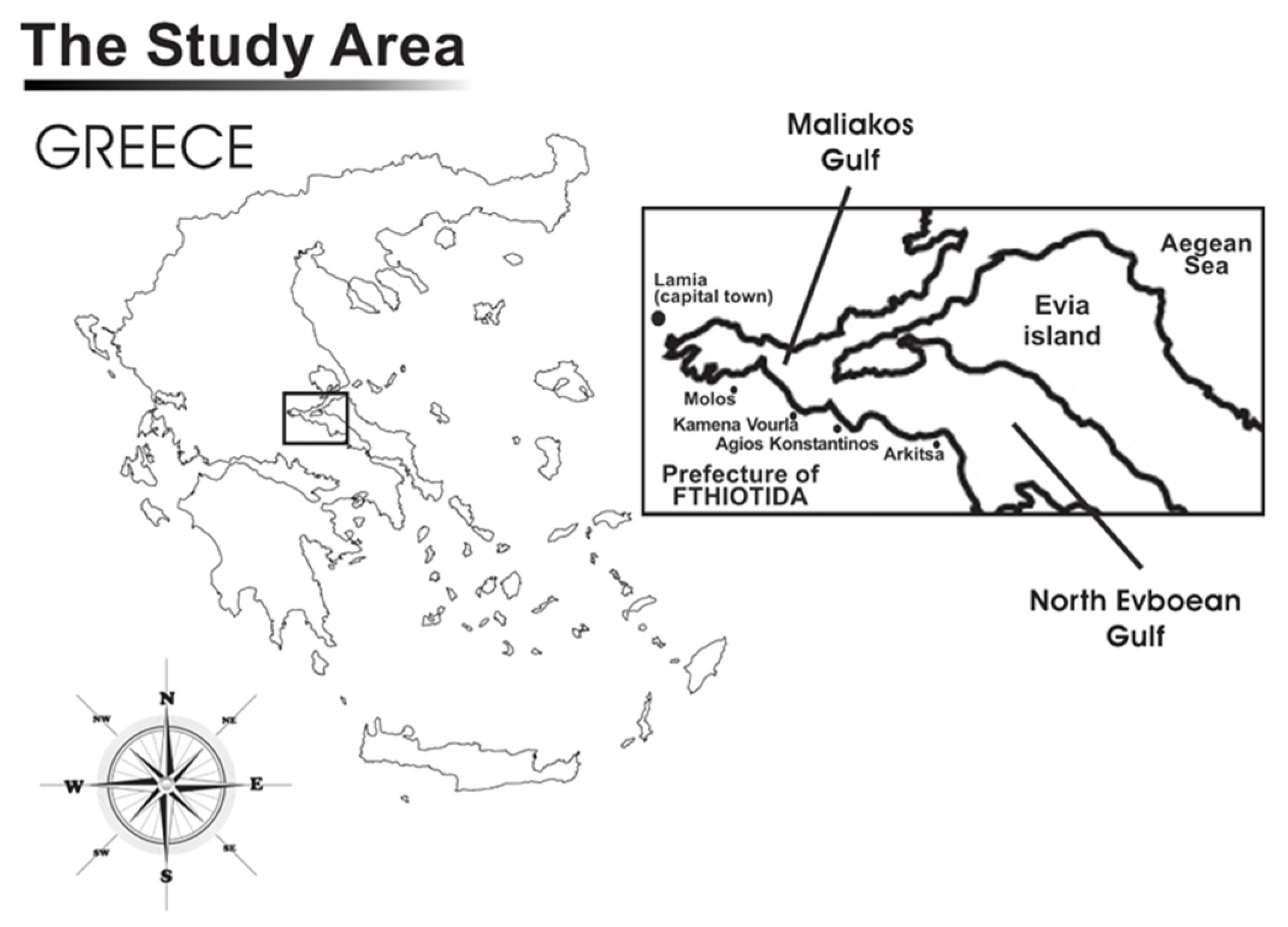


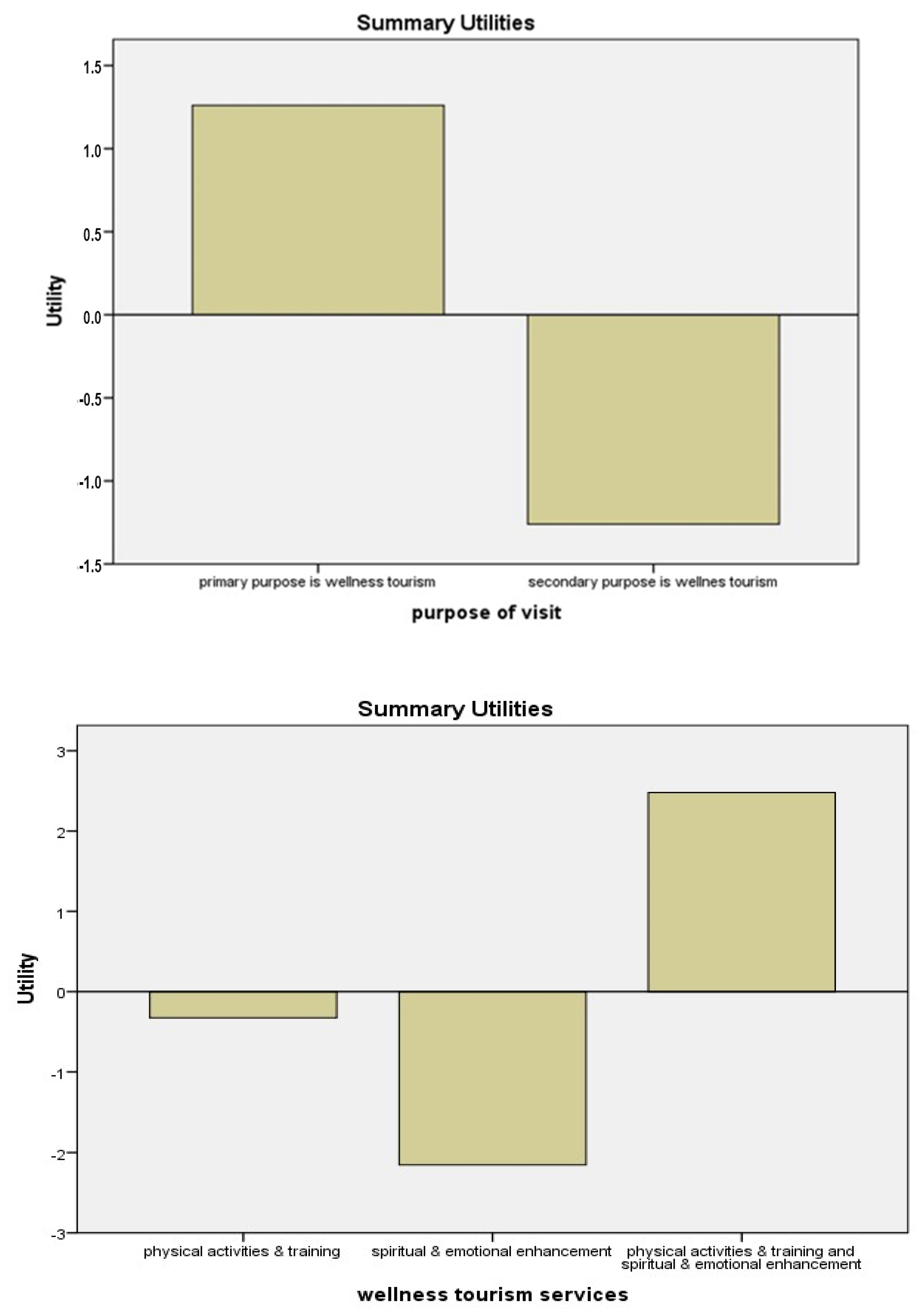

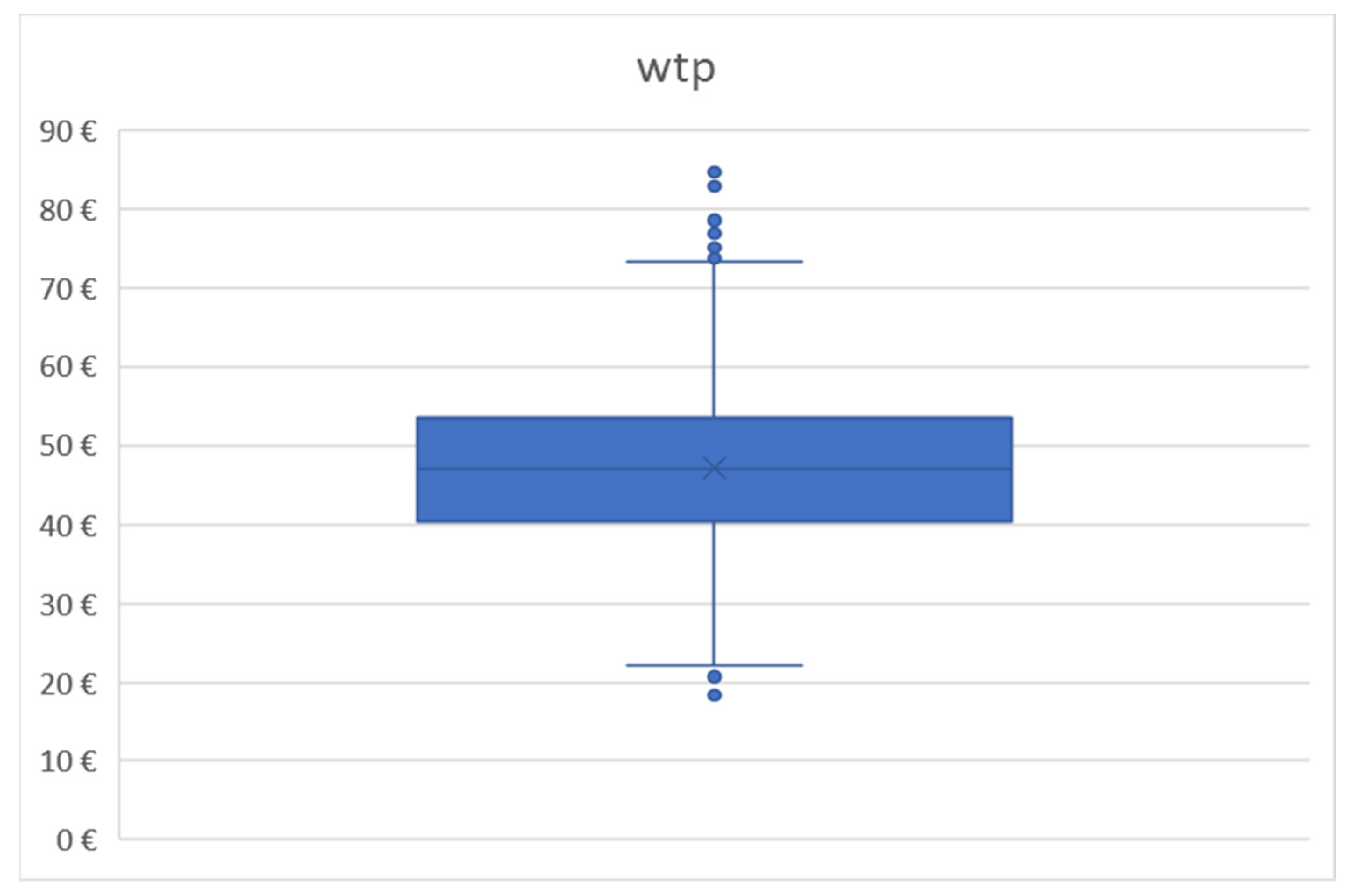
| Attributes | Levels |
|---|---|
| Time of visit |
|
| Duration of visit (days) |
|
| Purpose of visit |
|
| Wellness tourism services (Types of wellness activities) |
|
| Variable Name in the BLR Model | Interpretation of Variables | Unit of Measure—Variable Coding |
|---|---|---|
| bid | The amount of money offered | (EUR) |
| edu | Education level | Years |
| income | Monthly income level | (EUR) |
| age | Respondents’ age | Years |
| Believes that wellness tourism can be a mechanism for: | ||
| envirovar1 | The protection of the study area through their own responsible behavior (in terms of pollution and hygiene) | Binary variable coded with yes (1) and No (0) |
| envirovar2 | The importance of sustainability through natural resource exploitation (e.g., thermal spring water, seawater) | Binary |
| skills | Development of new skills in terms of human resources | Binary |
| quality | Improvement of the quality of the offered tourism experience | Binary |
| tourproduct | Enrichment of the provided tourism product (e.g., in regard to other sustainable forms of tourism such as fishery tourism) | Binary |
| facilities | Development of new tourism facilities (such as marinas for cruise boats and yachts) | Binary |
| entrepreneurship | Development of entrepreneurship (e.g., in the field of the food and beverage sector—gastronomy) | Binary |
| loyal | If respondents have visited the research area in the past | Binary |
| welltour | If respondents have visited and received wellness tourism services, in the past, in any area | Binary |
| stay | Duration of stay in the study area | Days |
| Attributes | Levels | Utility Estimate | Std. Error |
|---|---|---|---|
| Time of visit |
| −1.574 | 1.034 |
| −1.602 | 1.034 | |
| 0.897 | 1.034 | |
| 2.280 | 1.034 | |
| Duration of visit (days) |
| 0.840 | 0.796 |
| 0.493 | 0.934 | |
| −1.335 | 0.934 | |
| Purpose of visit |
| 1.262 | 0.597 |
| −1.262 | 0.597 | |
| Types of wellness activities |
| −0.326 | 0.796 |
| −2.153 | 0.934 | |
| 2.479 | 0.934 | |
| Constant | 8.371 | 0.660 |
| Attributes | Importance Values |
|---|---|
| Time of visit | 25.7 |
| Duration of visit (days) | 29.4 |
| Purpose of visit | 14.6 |
| Types of wellness activities | 30.3 |
| Observed | |||
|---|---|---|---|
| Predicted | Percentage Correct | ||
| NO | YES | ||
| NO | 301 | 89 | 77.2 |
| YES | 50 | 883 | 94.6 |
| Overall percentage (%) | 89.5 | ||
| Variables | B | SE. | Wald | df | Sig. | EXP(B) | 95% CI for EXP(B) | |
|---|---|---|---|---|---|---|---|---|
| Lower | Upper | |||||||
| bid | −0.199 | 0.019 | 114,649 | 1 | 0.000 | 0.820 | 0.790 | 0.850 |
| edu | 0.114 | 0.065 | 3.102 | 1 | 0.078 | 1.120 | 0.987 | 1.272 |
| income | 0.001 | 0.0001 | 3.116 | 1 | 0.078 | 1.001 | 1.000 | 1.001 |
| age | −0.024 | 0.013 | 3.304 | 1 | 0.069 | 0.976 | 0.951 | 1.002 |
| envirovar1 | 1.002 | 0.378 | 7.038 | 1 | 0.008 | 2.723 | 1.299 | 5.707 |
| envirovar2 | 0.521 | 0.298 | 3.061 | 1 | 0.080 | 1.683 | 0.939 | 3.016 |
| skills | 0.592 | 0.345 | 2.949 | 1 | 0.086 | 1.807 | 0.920 | 3.550 |
| quality | 0.747 | 0.447 | 2.796 | 1 | 0.095 | 2.110 | 0.879 | 5.063 |
| tourproduct | 0.668 | 0.368 | 3.293 | 1 | 0.070 | 1.951 | 0.948 | 4.016 |
| facilities | 0.968 | 0.397 | 5.955 | 1 | 0.015 | 2.632 | 1.210 | 5.725 |
| entrepreneurship | 0.619 | 0.357 | 3.002 | 1 | 0.083 | 1.857 | 0.922 | 3.739 |
| loyal | 0.649 | 0.311 | 4.368 | 1 | 0.037 | 1.914 | 1.041 | 3.517 |
| welltour | 0.491 | 0.296 | 2.747 | 1 | 0.097 | 1.634 | 0.914 | 2.920 |
| stay | −0.055 | 0.033 | 2.865 | 1 | 0.091 | 0.946 | 0.887 | 1.009 |
| Constant | 3.126 | 1.300 | 5.781 | 1 | 0.016 | 22.779 | ||
| Nagelkerke R2 0.602 Hosmer and Lemeshow 0.232 | ||||||||
Disclaimer/Publisher’s Note: The statements, opinions and data contained in all publications are solely those of the individual author(s) and contributor(s) and not of MDPI and/or the editor(s). MDPI and/or the editor(s) disclaim responsibility for any injury to people or property resulting from any ideas, methods, instructions or products referred to in the content. |
© 2023 by the authors. Licensee MDPI, Basel, Switzerland. This article is an open access article distributed under the terms and conditions of the Creative Commons Attribution (CC BY) license (https://creativecommons.org/licenses/by/4.0/).
Share and Cite
Ekonomou, G.; Kallioras, D.; Menegaki, A.N.; Alvarez, S. Tourist Preferences for Revitalizing Wellness Products and Reversing Depopulation in Rural Destinations. Sustainability 2023, 15, 16736. https://doi.org/10.3390/su152416736
Ekonomou G, Kallioras D, Menegaki AN, Alvarez S. Tourist Preferences for Revitalizing Wellness Products and Reversing Depopulation in Rural Destinations. Sustainability. 2023; 15(24):16736. https://doi.org/10.3390/su152416736
Chicago/Turabian StyleEkonomou, George, Dimitris Kallioras, Angeliki N. Menegaki, and Sergio Alvarez. 2023. "Tourist Preferences for Revitalizing Wellness Products and Reversing Depopulation in Rural Destinations" Sustainability 15, no. 24: 16736. https://doi.org/10.3390/su152416736
APA StyleEkonomou, G., Kallioras, D., Menegaki, A. N., & Alvarez, S. (2023). Tourist Preferences for Revitalizing Wellness Products and Reversing Depopulation in Rural Destinations. Sustainability, 15(24), 16736. https://doi.org/10.3390/su152416736








